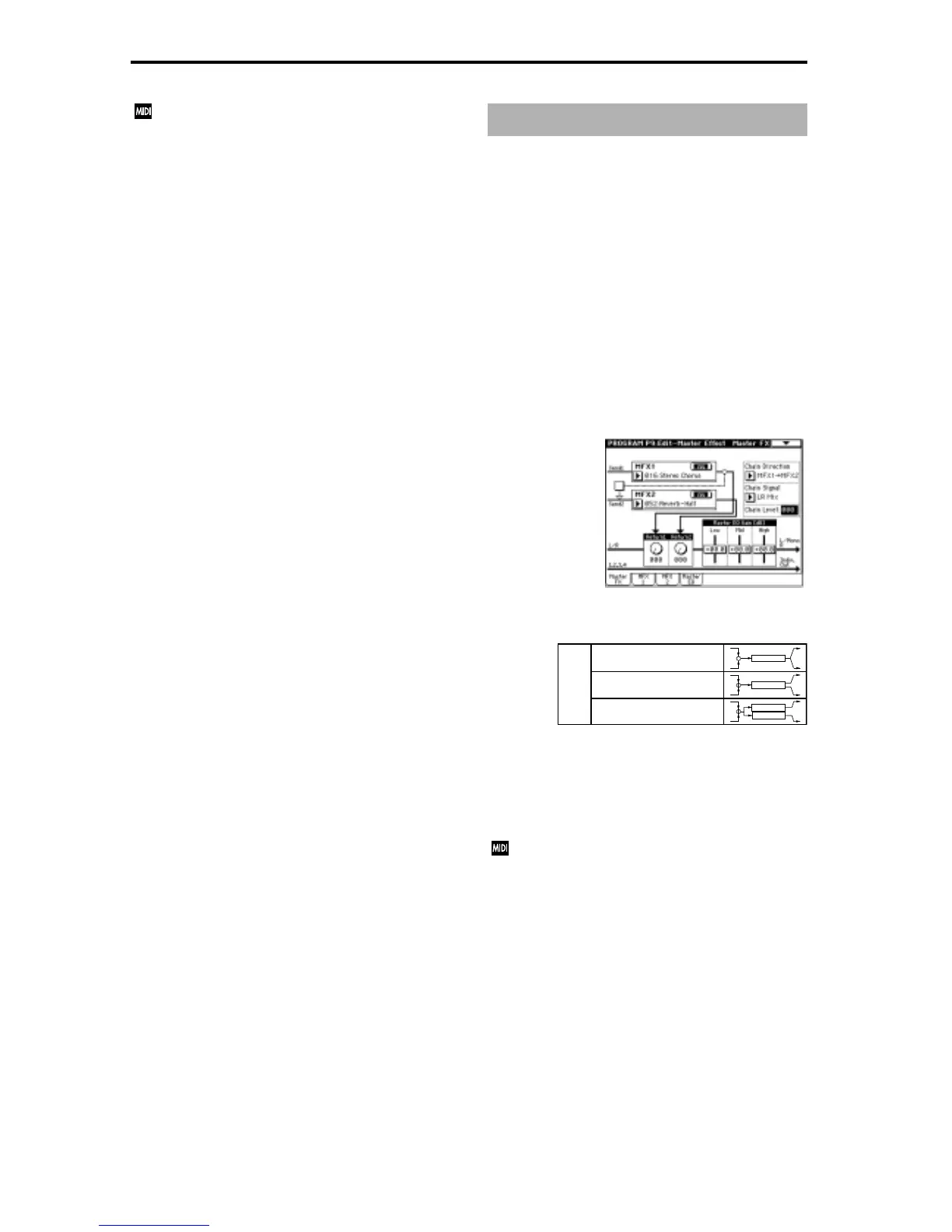150
“Send1” responds to MIDI Control Change CC#93 and
“Send2” responds to MIDI Control Change CC#91.
4. Controlling the Insert Effects via
MIDI
Using the Dynamic Modulation (Dmod) function enables
you to control all effect parameters in real-time during per-
formance from the controllers of the TRITON or a connected
MIDI sequencer. You can also control the Pan (CC#8),”
“Send1,” and “Send2” parameters in the same way.
4–1. Program mode and Sampling mode
You can control the parameters on MIDI Global channel
(MIDI Channel” (Global P1: 1–1a).
4–2. Combination mode
Use “Ctrl Ch” parameters of the “IFX1–5” tabs to set up the
control channels for IFX1, 2, 3, 4, and 5. Select an appropriate
option from Ch01–16, Gch, and All Routed.
Ch01–16: Select this option if you wish to control the param-
eters for each Insert Effect on different channels. The “*”
mark appears on the right of the number of the channel
routed to the corresponding Insert Effects.
Gch: Select this option if you wish to control the parameters
on MIDI Global channel “MIDI Channel” (Global P1: 1–1a).
This is a common setting.
All Routed: Select this option to control the parameters on
the channels (channels 1–16 that have a “*” mark) for the
timbres that are routed to the corresponding Insert Effects.
4–3. Sequencer mode and Song Play mode
Use “Ctrl Ch” parameters of the “IFX1–5” tabs to set up the
control channels for IFX1, 2, 3, 4, and 5. Select an appropriate
option from Ch01–16 and All Routed.
Ch01–16: Select this option if you wish to control the param-
eters for each Insert Effect on different channels. The “*”
mark appears on the right of the number of the channel
routed to the corresponding Insert effects. This option is
suitable if multiple tracks on different MIDI channels are
sent to the Insert Effects and you wish to control the param-
eters using one of the tracks.
All Routed: Select this option to control the parameters on
the channels (channels 1–16 that have a “*” mark) for the
tracks that are routed to the corresponding Insert Effects.
“All Routed” is a typical option. If you wish to control the
parameters on a channel, select one from Ch01–16.
1. In/Out
The I/Os of Master Effects MFX1 and MFX2 are mono-in/
stereo-out. “Send1” and “Send2” determine the send level
to the Master Effects (
☞“Routing” and “Mixer”). Stereo sig-
nals will be combined to a mono signal automatically and
sent to the effects.
The Master Effects do not output any Dry signals (signals
that are not processed by the effects). Therefore, they output
only Wet (signals that are processed by the effects) signals
(set via the “Wet/Dry” of the “MFX1” and “MFX2” tabs).
The output signals from the Master Effects are routed to the
L/R bus with the output level specified by “Return1” and
“Return2.” These output signals are mixed with the output
signals from the bus specified by “BUS Select” (P8: “Rout-
ing” tab in each mode) L/R, or with the output signals from
the bus specified by “BUS Select” (“Insert FX” tab in each
mode) L/R, then routed to the Master EQ.
Selecting “000: No Effect” will mute the output. The pro-
cessed signal will be output in one of the following ways,
according to the type of effects 001–089.
The possible routing of effect signal inputs and outputs is
indicated in the upper left corner of the block diagram.
Pressing the “On/Off” switch for MFX1 and 2 of the P9:
“MasterFx” tab in each mode will toggle between ON and
OFF. When OFF is selected, the output signals will be
muted.
The TRITON can also turn MFX 1 and 2 off by receiving
MIDI control change message CC#94 and CC#95
respectively. Value 0 will turn them off, and value 1–127
will turn them on. You can also use “Effect Global SW”
(Global P0: 0–1b) to turn MFX1 and 2 on and off. This
MIDI control is performed on MIDI Global Channel
“MIDI Channel” (Global P1: 1–1a).
Double-size effects
You cannot select double-size effects for Master Effects
MFX1 and MFX2.
Master Effects (MFX1, 2)
Stereo In - Stereo Out
Mono In - Mono Out
Mono In - Stereo Out
Effect
Effect
Effect
+
Effect
+
Wet
+

